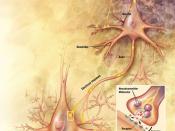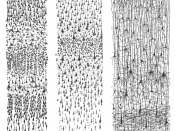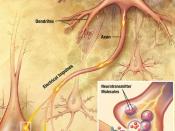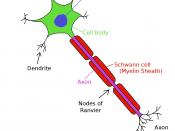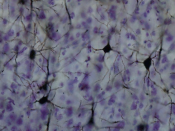Isaac Newton stated, ÃÂFor every action, there is an equal and opposite reaction.ÃÂ This statement applies to not only the study of physics but also to certain biological behaviors. When a person is cold, they reach for a blanket and when they are hungry, they reach for a snack. According to Baron, ÃÂEverything we think, feel, or do has a basis in biological processes and eventsÃÂ (42). When a person burns their finger with a match, a series of biological events occur inside the human body within a fraction of a second.
Through different research methods such as, varying observation techniques, recordings of neural activity, and live images of an intact brain, psychologists have been able to trace the series of events that occur when the nervous system goes into action.
The nervous systemÃÂs foundation is made up of countless neurons. Neurons consist of a cell body, dendrites, which carry information towards the cell, and axons, which carry information away from the cell.
According to Baron, ÃÂNeurons are one-way channels of communicationÃÂ (44). When a person burns their finger, it is the neurons that carry the information to the brain and then back to the finger to trigger a, ÃÂWow that burned!ÃÂ response. Neurons do not physically touch each other to transfer information; instead they rely on their action potential, which is a change in the electrical status of the neuron.
Neurons do not rely on a handshaking method of passing information, instead they communication by what is called, synaptic transmission. Baron explains the process:ÃÂWhen a neuron ÃÂfires,ÃÂ the action potential that is produced travels along the membrane to the axon terminals. Within the terminals are many synaptic vesicles. Arrival of the action potential causes these to approach the cell membrane, where they fuse and empty their contents. The chemicals released, known as neurotransmitters, travel across the synaptic gap until they reach the other cells receptor sitesÃÂ (47).
In other words, neurons communicate by creating a bucket train. The first one in line sends a package to the next, and so forth until it reaches the central nervous system.
The central nervous system is made up of the brain and the spinal cord. The spinal cord functions as a carrier for sensory information and various reflex actions. Afferent nerve fibers are responsible for the sensory reactions, and efferent nerve fibers control motor actions. Baron states, ÃÂSeemingly automatic actions, such as withdrawing your hand from a hot object, are common forms of reflex actionsÃÂ (51). The information from the spinal cord then moves towards the brain and undergoes another process.
Different portions of the brain are responsible for carrying out their own actions. To start, the thalamus is a section of the brain that can be referred to as a great relay station. It receives input from all senses except for smell, and transmits the information to different parts of the brain. Another section, the cerebral cortex, ÃÂSeems to be responsible for our ability to reason, plan, remember and imagineÃÂ (Baron 58). Specifically the right side of the brain would be responsible for the control of certain motor movements. Utilizing the burning finger example, once the information has reached the spinal cord and been sent to the thalamus, it could possibly be directed towards the cerebral cortex, where the reasoning would be, ÃÂmove your finger away!ÃÂ and then the action sequence would take place as the information is sent back out of the brain.
In conclusion, the biological behavior that occurs from a burning match is the result of a series of actions within a fraction of second. Hundreds, possibly thousands of neurons create a chain letter, sending information to the spine, where it gets relayed to the brain, distributed, analyzed, and the resulting action is sent back down through the spinal cord, back across the neurons to the destination, resulting in a reflex to move the hand away from the flame. To quote Baron, All aspects of behavior, including our consciousness, result from complex biological processes within our bodiesÃÂ (72).
Works CitedBaron, Robert A. Pscyhology. Needham Heights: Pearson Education, 2001.
